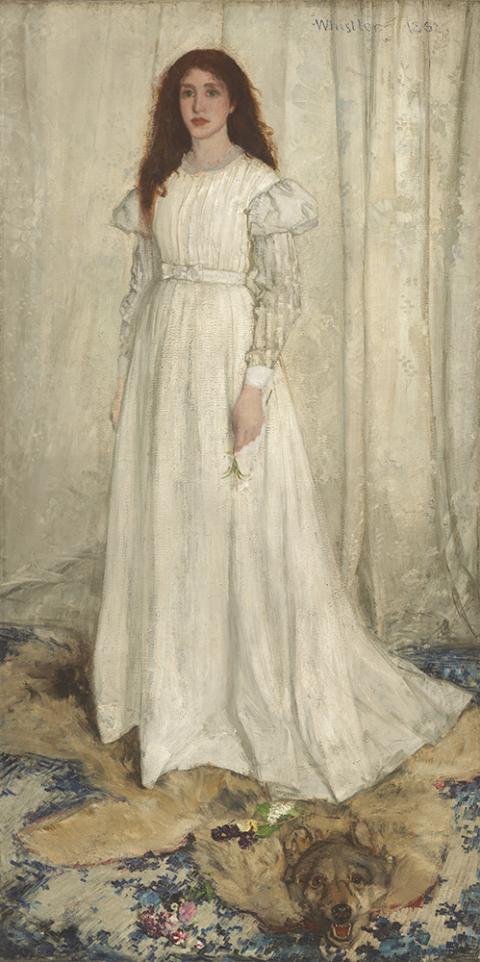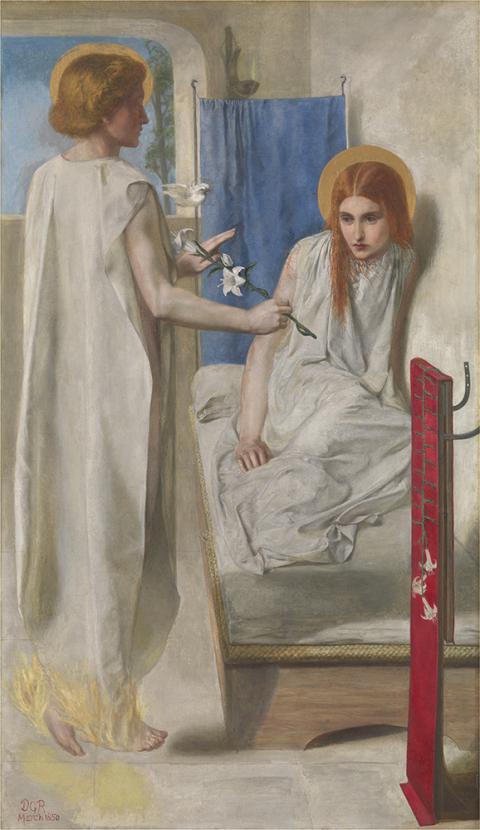
"Symphony in White, No. 1: The White Girl," 1861–1863, 1872, by James McNeill Whistler; see story below for full image (Courtesy of National Gallery of Art)
A Catholic woman languishes in obscurity behind the renowned painter for whom she posed. That claim and a corresponding effort to correct an ostensible injustice underpin the exhibit "The Woman in White: Joanna Hiffernan and James McNeill Whistler," on view through Oct. 10 at the National Gallery of Art in Washington.
A painter of crepuscular seascapes and portraits flirting with abstraction, Whistler's name is known even more widely than his oeuvre. "Arrangement in Grey and Black No. 1" (1871) — which also answers to "Portrait of the Artist's Mother" and "Whistler's Mother" — is one of the best-known artworks outside the United States by an American artist, claims Paris' Musée d'Orsay, which owns the picture. In the musical "Anything Goes," Cole Porter wrote in "You're the Top" of "Whistler's mama" in the company of Fred Astaire and Dante's "Inferno."
In contrast with the renown of Whistler (1834-1903), his Irish Catholic model and domestic partner Joanna Hiffernan, is so lost to history's dustbin that even her dates are puzzling. The exhibit, which the National Gallery conceived with London's Royal Academy of Arts and Whistler scholar Margaret MacDonald, places 1839 and 1886 as her life's bookends. But show co-organizer, the Royal Academy of Arts, offers a different set of dates on its website — which the Yale Center for British Art echoes — 1843-1903. A smorgasbord of other options can be found on the websites of the British Museum (c. 1843-1904), University of Delaware (1843-1904), Library of Congress (about 1843-?) and The Guardian (1843-1886).
Clearly, the exhibit has its work cut out for it, and it only partially achieves its avowed aim to afford a "more humanistic understanding" of Hiffernan. Its organizers are to be commended for bringing her to the fore, but they obfuscate an already murky situation.
Let's start with what goes right. The show and catalog reflect some of the resourceful detective work of MacDonald, emerita art history professor at University of Glasgow. Hiffernan — whose family name variously appears in records also as Heffernan, Hefferman and Hifferman — was born into a Catholic family in Limerick, the same Irish city about which Frank McCourt wrote so beautifully and hauntingly 150 years later in Angela's Ashes.

"The Relief Fund in Lancashire, The Major's Daughter, The Morning Before the Massacre of St. Bartholomew, and The Nun in 'Count Burkhardt' (Once a Week)," 1862 engraving after James McNeill Whistler (Courtesy of National Gallery of Art/Metropolitan Museum of Art)
She was one of five girls, although tragically, after the family moved to London, her youngest sister, Catherine, died of malnutrition at age 13-and-a-half. "They were rock-bottom poor," MacDonald said.
Hiffernan attended the church weddings of both of her married sisters, and was a witness at one, said MacDonald, who dates Hiffernan's birth to 1839 due to her baptismal record from that year. "All the census records were wrong," she said. (This assumes Hiffernan was baptized very soon after her birth, or she might have been born earlier.)
In 1860, Hiffernan and Whistler met, and she modeled for him and eventually became his domestic partner. Whistler's mother, part of the English church, may have been responsible for their not marrying, according to MacDonald. "His mother would have had 50,000 fits if he'd married in the Catholic Church," she said.

"Symphony in White, No. 1: The White Girl," 1861–1863, 1872, by James McNeill Whistler (Courtesy of National Gallery of Art)
Still, Whistler's biblical language — including one reference to 30 silver pieces — reflected his religious upbringing, and when his wife Beatrice died in 1896, he said he wished he had put up a candle for her. He entered a church and drew a shrine. "He still found it an emotional way to cope," MacDonald said.
When the Hiffernan family moved to England, curators speculate it was among many Catholics who experienced discrimination amidst ubiquitous Protestantism. Another educated guess is that Hiffernan was an artist in addition to a model, but here, too, historical record is thin. In the 1861 census, Whistler and Hiffernan lied about being married, likely to save face.
Over his family's disapproval of Hiffernan, Whistler named her his sole heir and gave her power of attorney, although she predeceased him. And most oddly, when Whistler unfaithfully fathered a son with a mistress, Hiffernan and her sister raised the boy.
If one suspends judgment about what many of her peers would have called "living in sin," Hiffernan sounds saintly, which is arguably how Whistler painted her in "Symphony in White, No. 1: The White Girl" (1862), part of the National Gallery collection. Whistler referred to this and other works as symphonies of color to emphasize their abstraction rather than literal subject matter. And when one presses one's nose as close to the paintings as guards permit, one sees gorgeous fields of brushstrokes and geometric shapes, each its own abstract composition.
Hiffernan stands off-center, her red hair ablaze and a flower dangling in her hand. Beneath her feet, strewn flowers rest upon an animal skin rug, perhaps a wolf or bear. Critics have seen the subject variously: the Virgin, Mary Magdalene, a bride, a symbol of lost virginity, first Communion, or a saint. Indeed, an x-ray scan reveals that Whistler had painted Hiffernan with her eyes looking upward ("as if to heaven," per the catalog), which suggests a saint. He would also portray her in another work as a nun.
Elsewhere in the exhibition, Dante Gabriel Rossetti's "The Annunciation" (1849-50), and its unusual decision to depict a red-headed Virgin roused in her bed, is suggested as an influence on the painting of Hiffernan. This is a plausible claim, given the closeness of the two painters.

"Ecce Ancilla Domini! (The Annunciation)," 1849–1850 painting by Dante Gabriel Rossetti (Courtesy of National Gallergy of Art/© Tate, London 2017)
But when one confronts the aspects of the exhibit that try to drill below the fascinating collection of hints to an otherwise-invisible woman, one finds oneself led in circles, unfortunately.
First, the show refers to Whistler's and Hiffernan's "partnership" in making the works. The viewer is not told whether every model is "partner" to every painter — and if so, should not Hiffernan's name appear on the label, or Saskia's on Rembrandt's paintings? — or whether Whistler's and Hiffernan's close relationship makes for unique collaborations. Even if the latter is so, the show does not (and cannot) offer evidence that Hiffernan played such a role.
The exhibit's critique of Whistler for presenting only his own view of Hiffernan, rather than a truer, essential picture, falls flat. No painter can achieve the latter, and Whistler made clear he was not after naturalism, but mellifluous color. One might also argue that Hiffernan would be altogether lost to history, as so many impoverished people were, if not for Whistler.
Midway through the exhibit, a wall text addresses race. "This selection of paintings of white women, dressed in white, by white artists reflects the lack of representation of people of color in mainstream Victorian visual culture," it states. It also allows that many of Hiffernan's English contemporaries would have judged her, on the basis of her "skin color, facial features, and distinctive reddish brown hair," as of "a separate Celtic race, subordinate to white Anglo-Saxons." How then can Whistler, who painted a woman who was not white in the opinion of the Victorian "biased racial hierarchy," be prosecuted for painting only white models?
How painted figures "dressed in white" reflect any lack of representation whatsoever confounds the viewer. "It shouldn't matter, should it?" MacDonald said. There was a "rather vigorous discussion about this, and this is what they wanted to say," she said. Pressed about that discussion, she added, "They were nervous. They were worried about the possibility that people would object to that. Was this the right moment?"
Advertisement
Race is quite relevant to the pictures, many of which the Lowell, Massachusetts-born Whistler painted during the American Civil War, but the show's framing is confusing. Was Whistler a product of close-minded times, or was he a particular rogue? Or was his portrayal of the red-haired Catholic beauty progressive for its Marian approach?
The wall labels do not reveal that Whistler was racist, although he had family on both sides of the Civil War, and was anti-Semitic. His racism was so out of step with his times that he embarrassed his friends, MacDonald said. It seems odd to encourage viewers to question whether Whistler represented enough sitters of color without also addressing his outright racism.
The simultaneous condemnation and praise sends viewers mixed messages, which feel like placeholders going on record to cover themselves, rather than helpful guideposts to help curious viewers sort out what they are seeing.
What remains unchallenged, interestingly, is the moral implication of the relatively affluent Whistler taking the powerless Hiffernan on as model and unmarried partner. Whistler later teetered on the brink of bankruptcy, but Hiffernan could not have known that when she met him, so could she really have consented? The show and catalog do not say.
Sadly, that is the best we can hope for presently for Hiffernan. The exhibit sheds valuable light on both artist and model and contextualizes these important artworks. It weaves religion into art history, where one would not expect its centrality. But the show also raises more confusing questions and leaves viewers mourning a fascinating woman, about whom we know far too little.






